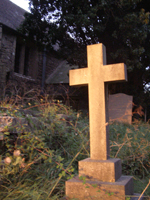Living Churchyards
 |
 |
 |
More than 6,000 British churchyards are now managed as sacred sanctuaries for wild flowers, birds, bats, reptiles and insects |
Note: For the most up-to-date information on Living Churchyards please see the news page here.
For links and resources, including useful downloadable fact sheets, see our resources page here.
As the countryside in Britain becomes more industrialised and urbanised, there are fewer places for wildlife to live and wildflowers to grow. But there are tiny areas in every village, town and even city that are holding out against the onslaught.
These are churchyards, and in some parts of the country they are the only protected eco-systems in their area where remnants of the local flora and fauna can survive.
The powerfully-named ‘Living Churchyards’ project is not so much a vision of the dead rising up as the dead providing sanctuary for species whose living space had been cut back.
Now more than 6,000 British churchyards run their small plots of land as sacred eco-systems – without pesticides, and mowing the grass only once a year – ensuring that birds, reptiles, insects and bats can thrive.
This is an example of restoring something that has always existed – the local churchyard – as an embodiment of the church’s core teachings about respecting nature.
The scheme has been outstandingly successful for several reasons. Firstly because it immediately makes sense, secondly because it is simple to execute, thirdly because it is theologically sound and fourthly because it enables millions of local people, through churches, schools and community groups, to be involved in a manageable environmental project.
The scheme is also spreading to municipal cemeteries, as well as to other faith groups in Britain – some Muslim and Hindu communities are working along similar lines.
It has brought together statutory bodies concerned with nature, heritage and the formal running of church sites.
For further details on how you might transform your own local churchyard into a Living Churchyard, please link to Caring for God's Acre which works primarily in Herefordshire, but can provide information that is relevant to locations throughout the UK.
Read the Parliamentary memorandum on Living Churchyards
Link to a story about the ancient Beltingham yew.
Link here for an article about the Millennium yew project and how 6000 saplings from 2000-year-old churchyard trees were planted in churchyards throughout Britain. Many of them will still be alive in another 1000 years.
Faith and Form's Fall 2010 issue features an article, Lay of the Land, giving an overview of schemes established by various religious communities that integrate the worship experience with nature. Buildings designed to exclude urban chaos and direct worshippers to their environment - both physically and spiritually - are beautifully photographed across large page spreads. The article covers the UK-based Living Churchyard Programme, acknowledging current sites and how they strive to promote nature, not control it.
|

